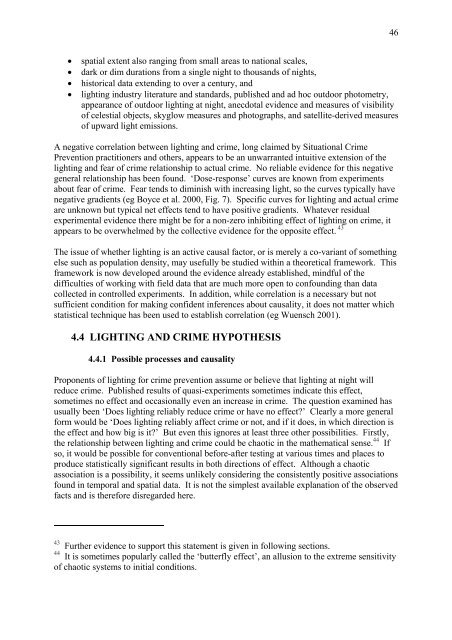Outdoor Lighting and Crime - Amper
Outdoor Lighting and Crime - Amper
Outdoor Lighting and Crime - Amper
Create successful ePaper yourself
Turn your PDF publications into a flip-book with our unique Google optimized e-Paper software.
• spatial extent also ranging from small areas to national scales,<br />
• dark or dim durations from a single night to thous<strong>and</strong>s of nights,<br />
• historical data extending to over a century, <strong>and</strong><br />
• lighting industry literature <strong>and</strong> st<strong>and</strong>ards, published <strong>and</strong> ad hoc outdoor photometry,<br />
appearance of outdoor lighting at night, anecdotal evidence <strong>and</strong> measures of visibility<br />
of celestial objects, skyglow measures <strong>and</strong> photographs, <strong>and</strong> satellite-derived measures<br />
of upward light emissions.<br />
A negative correlation between lighting <strong>and</strong> crime, long claimed by Situational <strong>Crime</strong><br />
Prevention practitioners <strong>and</strong> others, appears to be an unwarranted intuitive extension of the<br />
lighting <strong>and</strong> fear of crime relationship to actual crime. No reliable evidence for this negative<br />
general relationship has been found. ‘Dose-response’ curves are known from experiments<br />
about fear of crime. Fear tends to diminish with increasing light, so the curves typically have<br />
negative gradients (eg Boyce et al. 2000, Fig. 7). Specific curves for lighting <strong>and</strong> actual crime<br />
are unknown but typical net effects tend to have positive gradients. Whatever residual<br />
experimental evidence there might be for a non-zero inhibiting effect of lighting on crime, it<br />
appears to be overwhelmed by the collective evidence for the opposite effect. 43<br />
The issue of whether lighting is an active causal factor, or is merely a co-variant of something<br />
else such as population density, may usefully be studied within a theoretical framework. This<br />
framework is now developed around the evidence already established, mindful of the<br />
difficulties of working with field data that are much more open to confounding than data<br />
collected in controlled experiments. In addition, while correlation is a necessary but not<br />
sufficient condition for making confident inferences about causality, it does not matter which<br />
statistical technique has been used to establish correlation (eg Wuensch 2001).<br />
4.4 LIGHTING AND CRIME HYPOTHESIS<br />
4.4.1 Possible processes <strong>and</strong> causality<br />
Proponents of lighting for crime prevention assume or believe that lighting at night will<br />
reduce crime. Published results of quasi-experiments sometimes indicate this effect,<br />
sometimes no effect <strong>and</strong> occasionally even an increase in crime. The question examined has<br />
usually been ‘Does lighting reliably reduce crime or have no effect?’ Clearly a more general<br />
form would be ‘Does lighting reliably affect crime or not, <strong>and</strong> if it does, in which direction is<br />
the effect <strong>and</strong> how big is it?’ But even this ignores at least three other possibilities. Firstly,<br />
the relationship between lighting <strong>and</strong> crime could be chaotic in the mathematical sense. 44 If<br />
so, it would be possible for conventional before-after testing at various times <strong>and</strong> places to<br />
produce statistically significant results in both directions of effect. Although a chaotic<br />
association is a possibility, it seems unlikely considering the consistently positive associations<br />
found in temporal <strong>and</strong> spatial data. It is not the simplest available explanation of the observed<br />
facts <strong>and</strong> is therefore disregarded here.<br />
43<br />
Further evidence to support this statement is given in following sections.<br />
44<br />
It is sometimes popularly called the ‘butterfly effect’, an allusion to the extreme sensitivity<br />
of chaotic systems to initial conditions.<br />
46
















